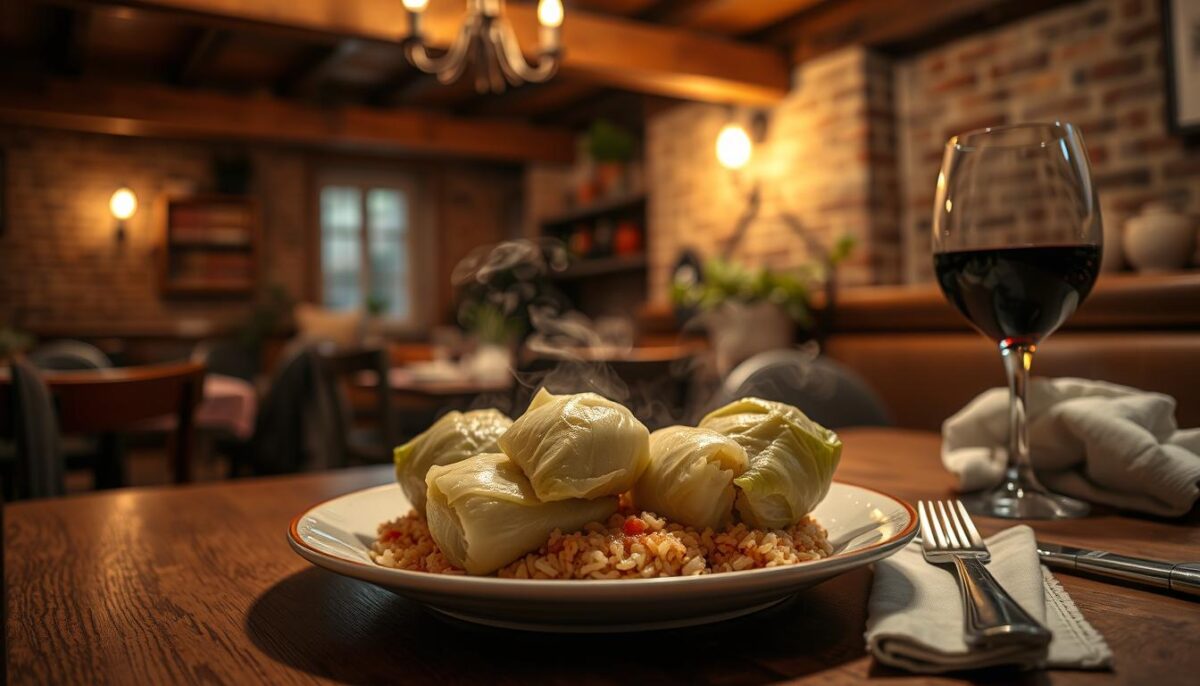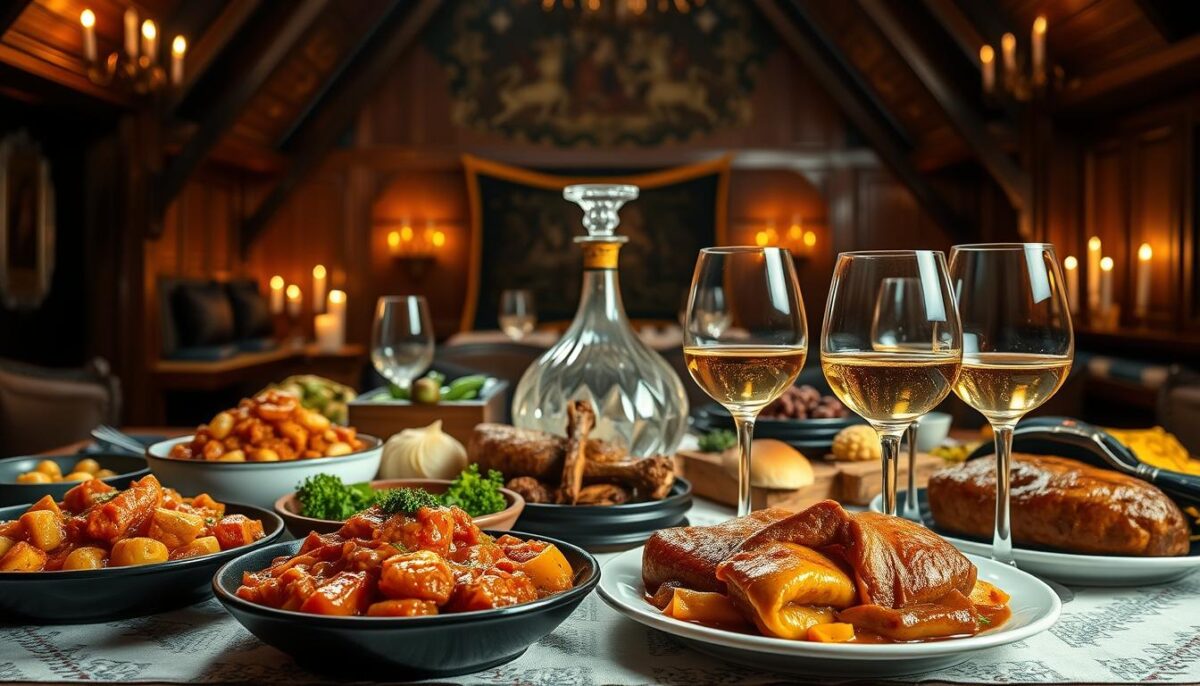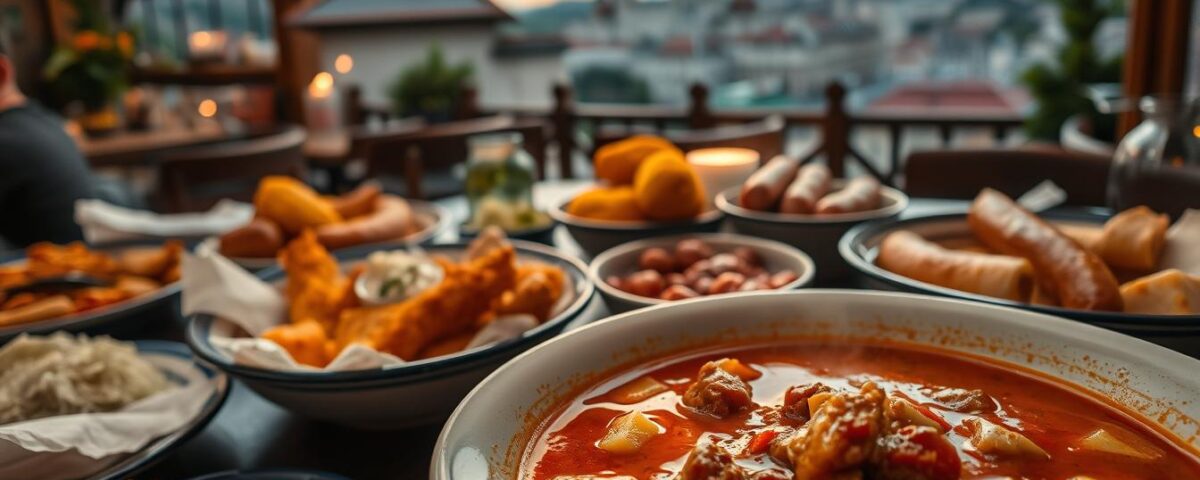
7 Traditional Dishes to Try in Vienna Before You Leave
June 10, 2025
Top Local Delicacies to Discover in Lisbon’s Hidden Eateries
June 10, 2025Did you know paprika isn’t just a spice here—it’s a cultural icon? Hungarians use over 1.5 pounds of this vibrant red seasoning per person annually. My first bite of smoky goulash in a tucked-away Budapest eatery taught me why. The rich broth, tender beef, and earthy paprika felt like a warm hug from a grandmother I never had.
Budapest’s food scene is a treasure chest of flavors. From crispy lángos topped with garlic and sour cream to modern bistros reimagining classics, every dish tells a story. I’ve spent years exploring markets, chatting with chefs, and savoring every bite so you don’t miss a thing.
This guide isn’t just a list—it’s a passport. You’ll discover where to find slow-cooked stews simmered for generations and learn why ingredients like caraway and fresh dill matter. Whether you’re craving comfort or curiosity, Budapest delivers.
Key Takeaways
- Explore traditional recipes passed down through generations
- Discover modern eateries adding creative twists to classics
- Learn why paprika and sour cream are kitchen staples here
- Find hidden spots loved by locals, not just tourists
- Understand how history shaped the city’s unique flavors
Introduction to Hungarian Cuisine
There’s a reason every meal here begins with soup—it’s the gateway to understanding this culture. My journey started at a family-run eatery where steam rose from ceramic bowls like edible fog. “You can’t rush good food,” the owner told me, stirring a cauldron of goulash that smelled like woodsmoke and memories.
My Personal Journey with Hungarian Food
I’ll never forget my first winter here. A blizzard raged outside as I devoured halászlé, a fiery fisherman’s soup. The heat from paprika bloomed in my chest while sour cream cooled my tongue—a perfect balance I’d later recognize in many traditional hungarian dishes. Locals taught me that recipes aren’t just instructions here—they’re heirlooms.
What Makes a Meal Truly Hearty
Three elements define these robust dishes:
- Layered flavors from slow-cooked bases
- Contrasts like tangy dairy against smoky spices
- Stories simmered into every bite
That goulash I tasted years ago? It contained seven generations of know-how. Chefs here treat soups as edible history books—each broth reveals conquests, trade routes, and family secrets. When you taste that depth, you’re not just eating—you’re time-traveling.
Historical and Cultural Roots of Hungarian Food
Hungary’s culinary map reads like a history textbook—every flavor tells of conquerors, traders, and creative home cooks. I once met a chef who described his pork stew recipe as “Ottoman spices meets Habsburg elegance.” That’s when I realized how layered this cuisine truly is.
Influences from Italian, Ottoman, and French Cuisine
- Italian artists brought pasta-making techniques in the Renaissance
- Ottoman troops introduced paprika and coffee during 150-year rule
- French chefs refined pastries for 19th-century aristocracy
I tasted this fusion at a countryside inn. Their pork roast used Turkish cumin with French braising methods—a delicious time capsule.
The Legacy of Goulash Through the Ages
Originally a 9th-century shepherd’s soup, goulash evolved into Hungary’s signature dish. Here’s why it sticks around:
- Peasants added beef during cattle drives
- 18th-century cooks caramelized onions for depth
- Modern chefs serve it stew-style with fresh bread
Last week, I watched a grandmother teach her granddaughter the “right” way to layer spices. That’s how traditions survive—one dish at a time.
Signature Ingredients in Traditional Hungarian Cuisine
I once watched a chef toss paprika into a sizzling pan like confetti. The air filled with smoky sweetness—a scent I now recognize as Hungary’s edible fingerprint. Two ingredients dominate kitchens here, transforming simple recipes into soul-warming classics.
The Role of Paprika and Sour Cream
Paprika isn’t just red powder here. During a farm visit, I learned about seven varieties—from delicate édesnemes (sweet) to fiery erős. The farmer grinned: “We match paprika to dishes like wine to cheese.” This spice does more than color food—it builds flavor foundations in stews and soups.
Sour cream plays yin to paprika’s yang. I discovered this balancing act in a cottage kitchen. A cook stirred dollops into paprikás csirke (chicken paprikash), transforming fiery broth into velvet. “The cream cools the heat,” she explained, “but lets the spice sing.”
| Paprika Type | Heat Level | Best Dishes |
|---|---|---|
| Édesnemes | Mild | Goulash, stews |
| Csípős | Medium | Fisherman’s soup |
| Erős | Hot | Sausages, marinades |
Chefs here use cream strategically. At a market stall, I tasted túrós csusza—noodles with cheese and cream. The dairy softened sharp flavors while amplifying dill and caraway. It’s culinary alchemy—turning bold elements into harmonious bites.
“Paprika without sour cream is like a violin missing its bow—both need each other to create magic.”
My paprika education peaked in Szeged, where they’ve grown peppers since the 1500s. A spice master let me taste fresh paste from oak barrels—earthy, complex, nothing like supermarket versions. That’s when I truly understood why this ingredient defines a nation’s palate.
Hearty Hungarian meals Budapest
The scent of caramelized onions and smoked paprika hit me as I pushed through the red-checkered curtain of a basement eatery. This wasn’t just dinner—it was a masterclass in how tradition thrives in the city’s kitchens.

Dishes That Define Dining Culture
Three bites changed my perspective forever. First: stuffed cabbage at a family-run restaurant near Keleti Station. Tender leaves hugged spiced pork and rice, simmered in tomato sauce sharpened with sauerkraut. It tasted like Sunday afternoons at grandma’s house.
Then came the túrós csusza—noodles drowning in fresh cheese and crispy bacon. At a market stall, the vendor winked: “We use curd cheese, not ricotta. Makes all the difference.” He wasn’t wrong. The tang cut through rich pork fat like a flavor symphony.
- Gettó Gulyás: Modern spins on classics (try their duck leg with cherry sauce)
- Két Szerecsen: Cozy spot for paprika-spiked stews
- Frici Papa: Where students devour budget-friendly plates
“Our recipes aren’t in books—they’re in our hands and hearts.”
I learned to seek places where menus change weekly based on market finds. One bistro served duck liver paté with quince paste—a French technique meets local ingredients. Another spot reinvented stuffed cabbage as bite-sized appetizers. Yet the soul remains: generous portions, layered flavors, and zero pretense.
Whether you choose a Michelin-starred restaurant or a hole-in-the-wall, these dishes connect you to generations of craft. Just follow the laughter and clinking forks—that’s where the real feast happens.
Exploring Traditional Hungarian Soups
A steaming bowl arrived at my table, its paprika-scented vapor whispering stories of generations. In Hungary, soup isn’t just food—it’s the overture to every culinary experience. Locals taught me that skipping the first course here is like arriving at a concert after the symphony starts.
Goulash Soup, Húsleves, and More
Goulash soup surprised me with its complexity. The broth glows like molten copper, infused with sweet paprika and tender beef. Unlike thicker stews, this version stays brothy—perfect for soaking up with crusty bread. At a countryside inn, I learned their secret: caramelized onions cooked low and slow before adding tomatoes.
Winter brings húsleves, a clear consommé with root vegetables and delicate noodles. A grandmother once told me: “We use chicken feet for collagen—makes your lips stick together!” Her version floated carrot stars and parsnip moons, proving even simple soups get star treatment.
Seasonal Variations and Family Traditions
Seasonal shifts transform ingredients:
- Spring: Fresh dill brightens fish broths
- Summer: Zucchini and peppers bulk up vegetable soups
- Autumn: Mushrooms foraged from forests enrich creamy blends
I tasted a potato soup that’s been in one family for 120 years. The recipe? Boiled spuds, smoked sausage, and a dash of vinegar—comfort distilled into a bowl. Regional twists fascinate too. Near Lake Balaton, they add catfish to goulash. In Transylvania, smoked plums deepen the flavor.
“A good soup needs three things: patience, a wooden spoon, and someone to share it with.”
For the best bowls in Budapest, follow lunch crowds to étkezdes (small eateries). Look for daily specials chalked on boards—if you see “leves” listed first, you’re in the right spot.
Delicious Hungarian Stews and Meat Dishes
The first time I lifted the lid on a bubbling cauldron of pörkölt, the aroma of caramelized onions and smoked paprika made my knees weak. This is where patience becomes flavor—dishes simmered for hours until the meat surrenders to the fork.
Pörkölt, Paprikás, and Gypsy Roast
Chefs here treat stews like liquid gold. At a countryside inn, I watched them layer raw onions beneath pork chunks—no oil needed. The onions sweat slowly, creating a sweet base for paprika to bloom. “Stir clockwise only,” the cook warned. “Disturbing the layers ruins the magic.”
Chicken paprikás taught me about balance. The bird simmers in a crimson sauce until tender, then gets crowned with cool sour cream. I once ate three bowls at Kispiac Bisztró, where they use free-range birds from nearby farms.
| Dish | Cooking Time | Key Ingredient |
|---|---|---|
| Pörkölt | 3-4 hours | Pork shoulder |
| Paprikás | 2.5 hours | Chicken thighs |
| Gypsy Roast | 5 hours | Beef shank |
Cult Favorites Like Stuffed Cabbage
At a winter festival, I joined locals rolling cabbage leaves around spiced meat and rice. “Grandma’s trick?” a cook whispered. “Add sauerkraut juice to the tomato sauce—cuts the richness.”
These dishes shine during holidays but comfort year-round. Look for versions where the cabbage stays slightly toothsome, not mushy. My favorite comes from Fülemüle Étterem, where they smoke the pork filling over cherry wood.
“A good stew should make you want to lick the bowl—and maybe the pot.”
When hunting authentic stews in the city, follow these clues:
- Clouds of steam escaping kitchen vents
- Menus handwritten daily
- Paprika stains on the chef’s apron
These meat-centric creations aren’t just food—they’re edible heirlooms. Every bite carries centuries of craft, from Ottoman spice routes to grandmothers guarding secret recipes.
Satisfying Hungarian Street Food and Snacks
The sizzle of dough hitting hot oil was my first clue I’d found something special. At the Great Market Hall, golden discs bubbled in fryers while locals debated toppings. Street food here isn’t just fuel—it’s edible theater.
Lángos – Crispy Comfort
My inaugural bite of lángos crackled like autumn leaves underfoot. Beneath the crisp exterior lay cloud-soft dough, warm from the fryer. Vendors artfully layer garlic butter, sour cream, and grated cheese—some even crown it with spicy sausage slices.
I learned to eat it folded like a taco while wandering stalls. “The secret?” a vendor winked. “Let the dough rise twice—patience makes it airy.”
Zsíroskenyér – The Bar Bite
Midnight at a ruin bar introduced me to this salty marvel. Thick rye bread gets slathered with pork cracklings (tepertő) and raw onion. It’s the ultimate side for frosty beers—a textural riot of crunch and creaminess.
| Snack | Best Time | Must-Try Topping |
|---|---|---|
| Lángos | Morning | Sour cream + cheese |
| Zsíroskenyér | Late night | Extra garlic sauce |
| Kolbász | Anytime | Smoked sausage |
Three tips for epic street eats:
- Follow lines—locals know whose dough fries hottest
- Seek stalls using wooden paddles to stretch batter
- Try lesser-known combos like apple-cinnamon lángos
“Good street food should make you smile first, then lick your fingers.”
These bites dissolve barriers between tourists and regulars. When you share a greasy paper plate of sausage-topped bliss, you’re not just snacking—you’re joining a delicious tradition.
Sweet Treats: Hungarian Pastries and Desserts
Biting into a chimney cake at dawn, the crackle of caramelized sugar echoed through the market like edible fireworks. This moment captured why desserts here aren’t mere endings—they’re celebrations woven into daily life.
Morning Magic in Pastry Form
Locals queue before sunrise for túrós batyu—pillowy dough parcels oozing sweet cheese. I joined regulars at a 6 AM bakery counter, savoring the contrast of warm sponge against cool filling. Nearby, spiraled kakaós csiga (chocolate buns) glistened with cocoa swirls. “We use real vanilla bean,” the baker shared, dusting another batch with powdered sugar.
Where Tradition Meets Texture
The iconic Dobos torta reveals Hungary’s pastry mastery. Seven layers of almond sponge cake alternate with chocolate buttercream, crowned with caramel shards. At Gerbeaud Café, I watched chefs torch the top—a 19th-century technique preserved like edible heirloom.
Street vendors reinvent classics too. Modern chimney cake stalls stuff crispy cylinders with dulce de leche or matcha cream. My favorite? A cinnamon-dusted version from a chain-smoking granny near Széchenyi Baths.
| Dessert | Key Ingredients | Best Paired With |
|---|---|---|
| Dobos Torta | Almond sponge, dark chocolate | Espresso |
| Chimney Cake | Caramelized sugar, walnut | Mulled wine |
| Túrós Batyu | Sweet cheese, phyllo | Fresh berries |
“Our cakes are architecture—every layer must hold stories.”
Three spots worth your sugar rush:
- Auguszt: Crown jewel for dobos torta since 1870
- Molnár’s Kürtőskalács: Perfect chimney cakes near the Danube
- Portobello: Modern twists on classic sponge bases
Whether you’re licking chocolate off your fingers at a tram stop or savoring forkfuls in gilded cafes, these treats turn moments into memories.
Recommended Restaurants and Local Markets in Budapest
Finding authentic flavors here feels like uncovering secret recipes scribbled on aged parchment. One rainy afternoon, a butcher whispered directions to a cellar restaurant where paprika-stained aprons hung like tapestries. These gems define Budapest’s culinary soul.
Top Spots for Authentic Hungarian Flavors
These four places deliver unforgettable experiences:
- Mátyás Pince (Castle District): Vaulted ceilings frame lamb stew with caraway dumplings. Their wine list features rare Tokaji vintages.
- Fakanál Étterem (Great Market Hall): Upstairs stall serving crispy rántott sajt (fried cheese) with lingonberry jam. Arrive before noon to beat lunch crowds.
- Stand25 Bisztró (District V): Michelin-starred takes on cheese-stuffed pasta. Chef Szabina’s duck liver pâté with quince will ruin you for all others.
At the Great Market Hall, follow your nose to the pickle barrels. I once traded coffee for a farmer’s family recipe—his smoked cheese with paprika crust still haunts my dreams. For sunset views, Holdudvar offers riverfront dining on goose ragout with sour cherry compote.
“We cook like our ancestors—when the pot’s empty, we start again tomorrow.”
Three tips for your feast:
- Book restaurants 3+ days ahead—locals reserve prime tables
- Markets peak 9-11 AM; vendors restock fresh cheese then
- Ask “Mi a legjobb ma?” (What’s best today?) for insider picks
Pairing Hungarian Meals with Drinks and Local Wines
A local chef once handed me two glasses: “This one makes the cabbage sing, that one turns beef into poetry.” That moment revealed Hungary’s secret—every dish has a liquid counterpart waiting to elevate it. From fiery stews to creamy cheese plates, the right drink transforms a meal into a symphony.

When Grapes Meet Paprika
Hungary’s countryside vineyards produce wines that mirror its cuisine: bold and layered. At a family-run winery near Tokaj, I learned how sweet Aszú balances sour cream-rich stews. Their 5-puttonyos vintage cut through a venison paprikás like velvet, proving opposites attract.
Three pairing rules I live by:
- Tokaji wines love creamy textures—try them with túrós csusza (curd cheese noodles)
- Full-bodied reds like Egri Bikavér stand up to beef and smoked cabbage
- Sparkling rosé brightens fried potato sides or stuffed peppers
In traditional eateries, expect dishes usually served with regional picks. A Budapest bistro paired their duck leg with cherry sauce with a peppery Kadarka—the fruit notes danced with the sugar-glazed skin perfectly.
“Wine here isn’t just a drink—it’s the missing ingredient.”
For vegetable-forward dishes, try crisp whites from Lake Balaton. Their citrus notes lift roasted vegetables or rice-stuffed tomatoes. Remember: Hungarian pairings prioritize harmony over rules. When in doubt, ask for “a helyi specialitás” (the local specialty)—they’ll pour magic.
Tips for an Authentic Hungarian Dining Experience
Finding the real deal in Budapest’s dining scene requires more than just a map—it demands local intuition. Over years of taste-testing, I’ve honed three rules: follow the laughter, sniff for paprika clouds, and never skip the soup course.
How I Choose the Best Eateries
Look for these telltale signs of authenticity:
- Handwritten menus changing daily
- Waitstaff who argue about paprika varieties
- More locals than cameras inside
My favorite cottage-style spot near Liberty Bridge serves csirke paprikás so tender, the chicken falls apart if you stare too hard. Their secret? Simmering for exactly 2 hours 47 minutes—timed to the second.
Smart Ordering and Seasonal Recommendations
Time your visit like a pro:
- Spring: Chase wild garlic in creamy pasta dishes
- Autumn: Hunt for venison stews with juniper berries
- Winter: Seek stuffed cabbage steaming in porcelain pots
Always start with broth-based soups—they’re the culinary overture. For mains, alternate between pork braised with caraway and chicken swimming in paprika cream. Save room for cottage cheese dumplings dusted with powdered sugar.
“The clock rules our kitchen—peppers ripen when they choose, not when you’re hungry.”
Conclusion
My notebook still smells of paprika and caramelized onions, its pages stained with memories of Budapest’s kitchens. Through smoky stews and flaky pastries, I discovered how food becomes a language—one that whispers tales of empires, family bonds, and creative resilience.
Every dish here feels intentional. Paprika’s earthy warmth in goulash, sour cream’s cooling swirls, and golden layers of chimney cake aren’t just ingredients—they’re cultural signatures. I’ll never forget biting into a chocolate-dobos torta near the Danube, its caramel shards cracking like edible stained glass.
For those planning their journey: seek places where menus change with the seasons. Chat with vendors at markets, taste slow-simmered soups, and let curiosity guide you. Traditional eateries thrive when visitors appreciate their craft—order boldly, linger over shared plates, and watch stories unfold through steam rising from ceramic bowls.
Budapest’s culinary magic lies in its balance—ancient recipes meeting modern flair, bold spices softened by fresh dairy. Whether you’re savoring stuffed cabbage or sipping Tokaji wine, each flavor becomes a thread in Hungary’s vibrant tapestry. Pack an appetite, ditch the map occasionally, and let your taste buds write the itinerary.
FAQ
What makes paprika so essential in Hungarian dishes?
Paprika is the soul of the cuisine here—it adds smoky depth, color, and warmth to stews like pörkölt or goulash. I’ve learned that sweet and hot varieties are used differently, but both tie the flavors together.
Is stuffed cabbage a must-try dish in Budapest?
Absolutely! Töltött káposzta, filled with spiced pork, rice, and sauerkraut, is a comfort classic. I love how the tangy tomato sauce balances the savory meat—it’s pure nostalgia on a plate.
Where can I find the best chimney cake in the city?
Head to street vendors near the Danube or markets like Central Market Hall. Kürtőskalács, with its caramelized sugar crust, is best fresh off the grill. My tip? Try it rolled in cinnamon or walnuts!
How do locals typically enjoy lángos?
Crispy fried dough topped with garlic, sour cream, and cheese—it’s a savory street food staple. I’ve seen adventurous versions with ham or jam, but the traditional combo is my go-to.
What’s the best way to pair Tokaji wines with meals?
Sweet Tokaji aszú pairs beautifully with foie gras or blue cheese. For dry whites like Furmint, I’d recommend spicy stews or roasted duck. Local sommeliers often guide diners—don’t hesitate to ask!
Are there vegetarian options in traditional eateries?
Yes! Dishes like lecsó (pepper and tomato stew), túrós csusza (noodles with cottage cheese), and sour cherry soup are hearty choices. Farmers’ markets also offer fresh, seasonal veggie plates.
Why is sour cream used so often here?
It adds creaminess and cools down spicy dishes. I’ve noticed it’s dolloped on soups, mixed into sauces, or even drizzled over desserts like palacsinta (crepes). It’s a versatile staple!
What’s the difference between goulash soup and pörkölt?
Goulash is a broth-based soup with veggies and beef, while pörkölt is a thicker stew simmered with onions and paprika. Both are iconic, but I crave pörkölt’s rich texture with a side of nokedli (dumplings).
Where should I go for an authentic dining experience?
Try century-old spots like Gettó Gulyás or Menza. For cakes, Gerbeaud Café is legendary. I also love exploring the stalls at Hold Street Market—it’s where locals shop and eat!
Can I find gluten-free options in Budapest?
Many modern restaurants label gluten-free dishes, and classics like grilled meats or főzelék (veggie stew) are naturally safe. Always ask—chefs here are happy to accommodate dietary needs.



